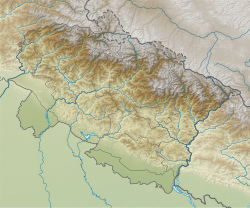| Pashulok Barrage | |
|---|---|
| Country | India |
| Location | Rishikesh |
| Coordinates | 30°04′27″N78°17′18″E / 30.07417°N 78.28833°E |
| Status | Operational |
| Dam and spillways | |
| Impounds | Ganges River |
| Length | 320 m (1,050 ft) |
| Spillway capacity | 13,200 m3/s (466,154 cu ft/s) |
| Reservoir | |
| Catchment area | 21,400 km2 (8,263 sq mi) |
| Normal elevation | 330 m (1,083 ft) [1] |
| Power Station | |
| Commission date | 1980 |
| Hydraulic head | 32.5 m (107 ft) |
| Turbines | 4 x 36 MW (48,000 hp) Kaplan-type |
| Installed capacity | 144 MW (193,000 hp) |
The Pashulok Barrage is a barrage located on the Ganges River just south of Rishikesh in Dehradun district, Uttarakhand, India.
